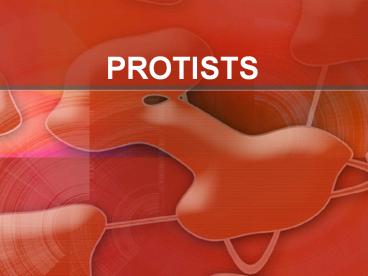PROTISTS - PowerPoint PPT Presentation
Title:
PROTISTS
Description:
PROTISTS PROTISTS COMMON EXAMPLES: Amoeba, paramecium, euglena, volvox, plasmodium EUKARYOTIC Have a nuclear membrane VERY DIVERSE GROUP most are unicellular ... – PowerPoint PPT presentation
Number of Views:139
Avg rating:3.0/5.0
Title: PROTISTS
1
PROTISTS
2
PROTISTS
- COMMON EXAMPLES
- Amoeba, paramecium, euglena, volvox, plasmodium
- EUKARYOTIC
- Have a nuclear membrane
- VERY DIVERSE GROUP
- most are unicellular, microscopic, aerobic
- Some are autotrophic, heterotrophic, sexual,
asexual
3
PROTISTS
- ENDOSYMBIONT THEORY
- Early eukaryotes developed symbiotic
relationships with prokaryotic cells - Prokaryotic cells lived inside eukaryotic cells
- Over time, the smaller prokaryotic cells evolved
with the eukaryotic cells to become mitochondria
and chloroplasts
4
PROTISTS
- EXCRETION AND OSMOREGULATION
- Water balance osmoregulation
- Done by contractile vacuole
- Wastes removed by diffusion
- RESPIRATION
- Carbon dioxide and oxygen diffuse in and out
5
PROTISTS
- REPRODUCTION
- Asexual
- Mitosis and cytokinesis
- Budding similar to mitosis except daughter cell
is smaller than parent - Schizogony nucleus divides many times and
cytoplasm divides to form many daughter cells as
there are nuclei
6
PROTISTS
- SEXUALLY
- Meiosis special nuclear division to reduce
chromosome number to haploid - Union of gametes diploid zygote
- Syngamy fertilization between two individuals
- Autogamy two gametes fuse within one organism
- Parthenogenesis development of organism from
gamete without fertilization - Conjugation exchange of nuclear material
between two individuals
7
PROTISTS
- DOMAIN EUKARYOTA
- KINGDOM PROTISTA
8
PROTISTS
- ANIMAL LIKE PROTISTS PROTOZOA
- Classified by method of movement
- PLANT LIKE PROTISTS ALGAE
9
PROTISTS
- PROTIST CLASSFICATION
- Separated by feeding habits (nutrition)
- Autotrophic
- Able to make own food
- Photosynthetic 30-40 of all photosynthesis
worldwide is done by algae
10
PROTISTS
- PROTOZOA
- Heterotrophic
- Unicellular
- 4 groups
- Sarcodinians
11
PROTISTS
- PHYLUM SARCODINA
- Aquatic, clear cytoplasm, irregular shape
- Move by extending lobes of their cytoplasm
- Pseudopods (false feet)
- Plasmolemma elastic cell membrane
12
PROTIST
13
PROTIST
- LABEL THIS AMEOBA
14
PROTISTS
- PHYLUM ZOOMASTIGINA
- Often called flagellates because they move using
flagella - Absorb food by diffusion through cell membrane
- Live off of dead or decaying organic matter or
some are parasites
15
PROTISTS
16
PROTISTS
- PHYLUM CILIOPHORA
- Ciliates found in fresh and salt water usually
free-living, most are larger than other protozoa - Pellicle, cilia, ectoplasm, endoplasm, food
vacuole, contractile vacuole - Micronucleus (exchanged during conjugation)
- Macronucleus (controls daily functions)
17
PROTISTS
- TRICHOCYSTS spindle shaped alternating between
bases of cilia used as anchor and to paralyze
prey - Oral groove shallow furrow on one side of cell
used to gather food - Locomotion cilia avoiding reaction ? contact
with unfavorable conditions and will move away - Reacts to contact, temperature, gravity, water
currents, electric currents, acidity and other
chemicals
18
PROTISTS
- Reproduction
- Mitosis every 6-12 hours
- Conjugation become sticky and adhere to each
other at oral groove and exchange nuclear material
19
PROTIST
20
PROTISTS
- PHYLUM SPOROZOA
- Members cannot move
- Reproduce by producing spores
- All endoparasites
21
PROTISTS
22
PROTISTS
- PLANT LIKE PROTISTS
- Most perform photosynthesis
- Contain chlorophyll in chloroplast and possibly
other pigments - Divided into groups by pigment color
23
PROTIST
- PHYLUM EUGLENOPHYTA
- Usually free-living (not a parasite)
- Pellicle covering membrane maintains shape
- Ectoplasm, endoplasm
24
PROTISTS
- Movement toward light using flagella flagella
pulls cell euglenoid movement ? expansion and
contractions of entire cell - Nutrition can capture food can absorb
nutrients from water or carry on photosynthesis
25
PROTISTS
26
PROTISTS
- PHYLUM CHLOROPHYTA - GREEN ALGAE
- Contain chlorophyll b is their main type (which
is very similar to land plants) - Some reproduce sexually
- Examples desmids, spirogyra
27
PROTISTS
28
PROTISTS
29
PROTISTS
30
PROTISTS
- PHYLUM HETEROKONTOPHYTA
- Red algae, brown algae, golden algae
- RED ALGAE
- Grow in warm salt water habitats toward surface
or deep water
31
PROTISTS
- BROWN ALGAE
- Multicellular and live in cool salt water
habitats - Includes giant kelps
32
PROTISTS
- Used to make a variety of products
- As a thickening agent in puddings, ice cream
33
(No Transcript)
34
PROTISTS
- GOLDEN ALGAE
- Some species are colorless, but the vast majority
are photosynthetic. - particularly important in lakes, where they may
be the primary source of food for zooplankton.
35
(No Transcript)
36
PROTISTS
- PHYLUM DINOFLAGELLATA (termed Pyrrophyta in your
book) - Nearly all have flagella
- Most grow in salt water
37
PROTISTS
- DINOFLAGELLATE
38
PROTISTS
- Cause the red tide
- Several microscopic marine algae are notoriously
poisonous to hapless humans who consume them in
shellfish. - some species are poisonous to animals which feed
upon them directly or indirectly.
39
PROTISTS
40
PROTISTS
- FUNGUS-LIKE PROTISTS (MOLDS)
- CHARACTERISTICS
- MOST ARE SMALL AND LIVE IN DAMP PLACES
- PROTISTS THAT ACT AS DECOMPOSERS ARE CALLED MOLDS
- DIVIDED INTO 3 GROUPS
41
PROTISTS
- PLASMODIAL SLIME MOLDS
- Can weigh as much as 50 grams and be as large as
a human hand (one cell!) - Single cell with many nuclei
42
Myxomycota - plasmodium
43
PROTISTS
- CELLULAR SLIME MOLDS
- ALTERNATES BETWEEN A SPORE PRODUCING FRUITING
BODY FORM AND AN AMEBALIKE FEEDING FORM
44
- The phyla of slime molds
45
PROTISTS
- WATER MOLDS
- DECOMPOSERS IN FRESHWATER ECOSYSTEMS
- SOME ARE
46
PROTISTS
- IMPORTANCE OF PROTISTS
- ECOLOGICAL ROLES
- Provide an essential food base in aquatic food
chains































